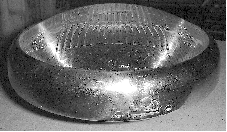Last updated: 3rd December 2024
Improving the quality of Austin Seven Headlights
It is not always realised that improvements in the efficiency of your headlights is not only down to the voltage and wattage of the bulbs. Austin Seven owners are always talking about the ‘candle power’ of their headlights and some, including myself, have converted to 12 volt to improve the situation when driving at night. This is not the full answer.
The answer lies in the glass at the front of the headlight. Of course, if your reflectors are in a poor state this will also effect the efficiency of your lights but all things being as they should the glass, in my opinion, is the most important.
In my early attempts to improve my headlights, I always used the lens from the front of the Ruby headlights. I call it a lens for that is what it is. When I used 6 volt motorbike light units and my current 12 volt Lucas 700 units I was still not completely satisfied as I could never seem to focus the beam in a useful way unless it was pointed down on the road a few yards in front of the car.

All has now become clear and its all down to those lenses on the front of the
lights.
The Austin Seven lens was designed to produce a pattern of light, fairly close to the car, but was designed to take the light from the reflector behind the bulb and form it into a pool of light instead of a wide beam. To dip the light, (nearside only) the reflector was mechanically turned inside the headlight shell, therefore a dip beam, as we know it today, was not included.

The Lucas 700 style light is a different beast altogether. The lens actually forms two different beams of light depending on the position of the filament in the bulb. The main beam is a long distance elliptical beam which is intended to be almost parallel to the road whilst the dip beam is a flat topped beam which is obviously angled down towards the road. The lens also imparts some sideways angular direction to the dipped beam so that it aims towards the nearside kerb. If you look at a Lucas 700 light you will see an arrow pointing to the nearside.
So how can we apply this to A7’s without the unsightly, oversize lens bezel. It is not that difficult!
You need to grind off the lip around the edge of the Lucas 700 light unit, not a sealed beam unit, but one with a metal reflector, until it will just slip into the headlight front cowl.
WARNING. Make sure you wear safety goggles to prevent any glass from getting in your eyes. You should always use eye protection when using a grinder anyway!




It will take about half an hour per light unit, gently remove the turned up metal lip and keep going removing some of the glass lip as well. Keep rotating the light unit so you are removing material uniformly off all round. Eventually you will be able to slip it into the chrome ring.
Now put a bead of clear silicon sealant around the very edge of the glass lens and clip into the chrome bezel using the normal ‘W’ clips.
Clean off any excess silicon that leaks out onto the face of the lens and that is one done. Repeat with the other light unit.

If you are still using 6 volt then you need the Lucas 700 light units for ‘prefocus’ bulbs as these are still available in both 6 and 12 volt.
 When
you come to convert to 12 volt (if you do!) then you only need change the
bulb. If you have converted, or intend to convert, to 12 volt then the better
lamp units are Lucas code LUB322.
When
you come to convert to 12 volt (if you do!) then you only need change the
bulb. If you have converted, or intend to convert, to 12 volt then the better
lamp units are Lucas code LUB322.
Quite by accident! The glass bulb shape of these bulbs is very similar to the bulbs used in the 1930’s.
This article, written by Anon, originally appeared in CA7C Seven Focus in Jan 2001 pp 18-20.